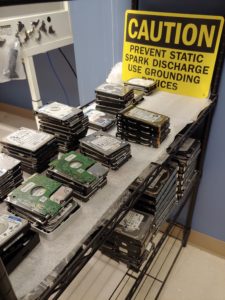 At Datarecovery.com, we’ve implemented controls at each of our laboratories to prevent electrostatic damage (ESD) from affecting hard drives, solid-state drives (SSDs), and other devices with exposed printed circuit boards.
At Datarecovery.com, we’ve implemented controls at each of our laboratories to prevent electrostatic damage (ESD) from affecting hard drives, solid-state drives (SSDs), and other devices with exposed printed circuit boards.
When handling storage media, our staff wears electrostatic grounding straps. Engineers wear anti-static smocks and footwear, and our flooring is designed to reduce static charge accumulation.
This is particularly important for our facilities: We work directly with sensitive electronic components, and ESD can introduce significant hazards. A typical “static shock” can generate 35,000 volts, but many ESD events are imperceptible to humans — we only feel the shock when the voltage is higher than about 3,500 volts.
When electronic components are subjected to high voltages with a moderate peak current, damage can occur. In certain circumstances, this can lead to data loss.
Modern electronics have some ESD protection
Our laboratories take extreme precautions to prevent ESD damage, but we work directly with sensitive electronic components. Under “typical” conditions, static electricity usually won’t damage hard drives, SSDs, or other storage devices.
Why? Modern hard drives have built-in ESD protection called transient voltage suppression (TVS) diodes, which practically limits the danger of permanent damage.
This protection varies from component to component — and even the best protection has limitations. ESD protection diodes have a maximum allowable voltage, current, and power dissipation ratings, and an extreme static shock could exceed one or more of those characteristics.
While static probably won’t kill your hard drive, don’t take the risk
Ultimately, it’s not likely that your hard drive will be damaged by electrostatic shock.
But it’s also unlikely that your hard drive will suffer a head crash within three months, or that you’ll accidentally format your device, or that your computer will catch on fire — and while those circumstances are unlikely, they still happen every day to a small percentage of computer users.
For that reason, we strongly recommend using appropriate static protection for hard drives, SSDs, and other devices. That’s especially true when sending media to a data recovery company: If your device has already failed, you certainly don’t want to take any steps that could make the problem worse.
To limit the chances of ESD damage:
- Wear a grounding strap when handling storage media.
- If you don’t have a grounding strap, you can ground yourself by touching a metal surface that is connected to the ground.
- Avoid walking on carpeted surfaces when holding storage media.
- When shipping devices with exposed circuit boards, place the device in an anti-static bag (if available) or a plastic page.
- Wrap storage media in at least 3-5 inches of bubble wrap. Tape all sides of the packing material to prevent the drive from slipping out during shipping. Do not use packing peanuts or other loose materials.
Datarecovery.com provides free evaluations for damaged hard drives, SSDs, and other storage devices. We support our services with a no data, no charge guarantee: If we’re unable to recover data, you don’t pay for the attempt.
To schedule an evaluation, submit a case online or call 1-800-237-4200 to speak with an expert.




